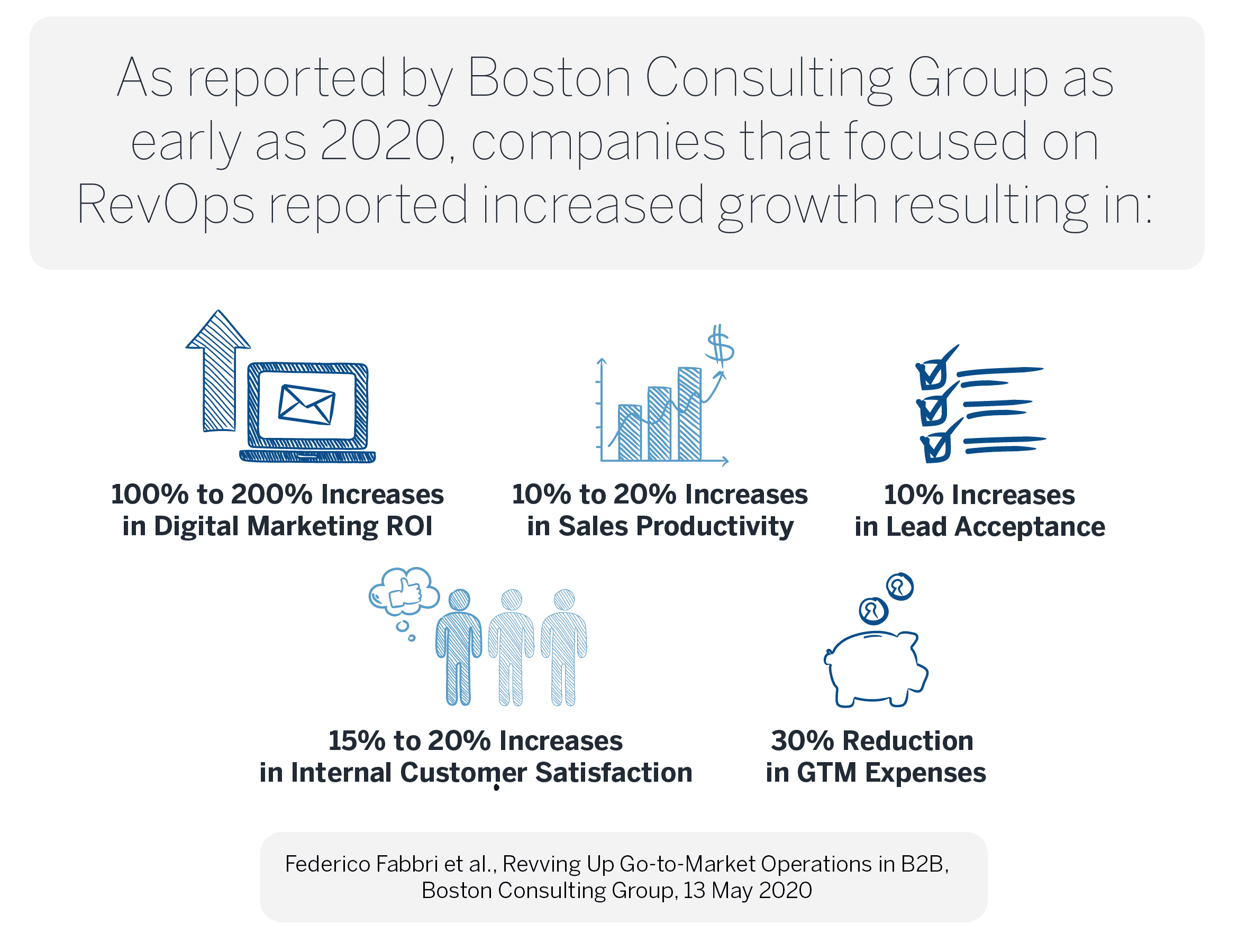Over the past few years, RevOps has taken the spotlight in revolutionizing companies. It’s one of the most important trends that is empowering companies to stay ahead of trends and proactively respond to them. By aligning your people, marketing, sales, data, customer journeys, and processes, you can achieve success. RevOps enables decision makers and customer-facing employees to see through data noise and be able to focus on accurate, relevant, and valuable data to increase customer trust and retention.

A recent Forrester Consulting Total Economic Impact™ (TEI) study, commissioned by Riva, provided projected results based on an aggregate model of a single composite organization of four companies that invested in Riva for their Data Operations integration. The results included:
- 352% ROI
- $7.5M Present Value of Benefits (PVB), in part from time savings and productivity lift for end users
- $5.84M Net Present Value (NPV)
- Less than 6 months to payback
In this post, you’ll read about four trends that are changing the way companies think about, leverage, and respond to customer data and why RevOps data integration is a solid investment. Whether you’re a CISO, an IT leader, an employee supporting your customers’ journeys, or a stakeholder charged with helping your teams navigate the paths to short- and long-term success, we encourage you to read on.
Top 4 RevOps Trends
1. Seamless RevOps Integration Creates More Meaningful Customer Interactions
From Salesforce and other CRMs to email, calendar, contacts, and other collaboration apps like Teams, Works, Zoom, and Slack communications, different revenue and communications platforms are essential to every business – irrespective of the size! Odds are high that one of these apps is your core interaction system of record (CRM), and the other (your email and calendaring platform) serves as your critical system of daily and weekly dynamic communications and action with your customers.
How important is seamless RevOps and CRM integration? Every company and organization in every vertical from financial services and insurance through manufacturing, retail, legal, accounting, real estate, post-secondary education, and others, is faced with the same challenge – how to reliably, consistently, seamlessly, and securely integrate customer data and how to control how it is used within their organization. Different teams and users rely on different platforms—CRM, email, communications, and more—and enormous volumes of customer data from multiple sources. Different types of data get gathered each and every day – 24 hours a day – in each of these systems.
Without seamless top-to-bottom RevOps integration, this data ends up being stored in disconnected siloes! As a result of how companies gather data across multiple channels, teams and users end up being required to manually search for, gather, and update data from these siloes to engage with customers along their journeys. Your teams end up spending unnecessary time, energy, and frustration trying to manually resolve and overcome data errors, omissions, inconsistencies, and redundancies across multiple sources. This inevitably causes employee stakeholders to lose trust in your company’s data. And what’s the worst possible outcome of a disconnected system and data that’s not aligned? Customers (and employees) are choosing to move on as a result of being frustrated and ill-served by the systems that are supposed to make their lives and journeys better.
Rare are the leaders in a business who appreciate the full hidden value and financial impact of identifying and understanding how to overcome these data challenges. And yet, it is these same leaders who are constantly called upon by shareholders, board members, management, and employees alike to invest in technologies to improve business outcomes. Revenue operations and the value of cohesive and automated data alignment is one of the fastest growing and critical trends that lead to success across all industries.
Moving from gathering data to being able to seamlessly automate, curate, secure, and properly provide accurate, reliable, and relevant customer-journey data is now a key deliverable of every revenue data operations solution. If your revenue operations and collaboration platforms do not automate these processes and distribute high-quality, trustworthy data to your teams for more meaningful customer interactions, the downward trend to failure is pretty much guaranteed!
The upward side of that trend happens when data-empowered employees (sales teams, advisors, customer-journey support staff), management, and go-to-market teams are aligned to use harmonized data to make better business decisions.

Anchoring decisions based on reality rather than opinion, clarity rather than bias, and quantitative facts rather than qualitative assumptions is core to improved customer journey management, employee retention, and success. As industry leaders embrace revenue ops technologies, their organizations experience marked productivity and data accuracy improvements because their staff is no longer hampered by repetitive data entry—or stymied by incomplete, inaccurate customer histories.
2. Balance Business Needs with Privacy, Security, and Compliance
Every organization must strike an increasingly delicate balance between delivering comprehensive and up-to-date customer data to end-users while meeting expanding data privacy, governance, security, and compliance requirements. Accurately recorded and properly managed customer data must be available across business applications for data-empowered employees to serve customers better and grow business—but sensitive data must be carefully governed to prevent misuse or disclosure (unintended or other) by unauthorized parties.
As the result of highly publicized data breaches, financial penalties, and increased legislation and regulations that govern security and sharing of data (MNPI, GDPR, California Consumer Privacy Act, and others), companies of all sizes need advanced data governance processes that relate specifically to how they capture, store, and create data flows. Accordingly, all organizations must be able to prove they ensure staff can see only the data they’re authorized to, that personal and customer data is stored and secured in approved applications and locations, and that their processes diligently enforce appropriate safeguards to protect sensitive data.
How well is your company keeping up with this trend?
Data governance plays a critical role across all companies. For companies in regulated industries, well, it’s more than just critical – it’s required. And, it takes more than a company just saying it’s taking care of data. Regulated industries require proof of oversight, consistency, required processes, and diligence. To achieve effective data governance, leaders in regulated industries like financial services, and non- regulated yet high-security environments, must follow and prove they are implementing related procedures and key best practices. To achieve this, companies usually start by establishing a single source of truth and creating an architecture that consolidates customer data across multiple platforms. Prioritizing data quality is crucial because poor-quality compromises data governance and compliance efforts and more (see below – Optimizing Data Quality to Feed AI.).
Core to achieving data security and governance is an approach that simplifies and automates user adoption, data visibility, and accuracy of your CRM data. This, in turn, encourages end-users to become active participants in ensuring data accuracy. This results in higher data quality, data trust, and more effective governance – and makes their lives easier.
The fulcrum on which data governance relies is data observability. Data observability enables administrators and managers to catch errors and inconsistencies before they escalate. By avoiding the indiscriminate adoption of single-purpose applications, companies can avoid the path that inevitably leads to technical debt and complicated data management. Following best practices and leveraging technologies through RevOps and customer data operations allows data governance, ensured data security, compliance, and usability to become part of day-to-day operations that lead to shared success.
3. Optimizing Data Quality to Feed AI
The increasing importance of Artificial Intelligence (AI) is creating a lot of excitement and opportunity across all industries. Machine learning, a form of AI, is being embraced to analyze comprehensive customer, revenue, and production data. Rather than replacing staff, AI now helps sales teams, advisors, and data-empowered employees by identifying and proposing “next best actions” for interactions, growth, and profitability. And what is the MOST important factor in enabling ChatGPT (and other Large Learning Modules), Machine Learning, and other AI strategies to deliver on their promise? The accuracy of the data consumed by your AI platform. Without highly relevant data and quality, poor AI is worse than no AI at all!
Consumer-oriented AI-driven technologies like ChatGPT have gained amazing user adoption for their diverse capabilities, such as writing papers, planning itineraries, and creating apps. Yet, these technologies are only as good as the data they are trained on. Large Language Models (LLMs) like ChatGPT generate outputs based on the information they receive and the data they consult, making probability-based predictions. If the data used for training is inaccurate, incomplete, conflicting, or outdated, AI’s conclusions and recommendations can be misleading or harmful.
This issue is especially critical when AI is applied to enhance sales enablement and make “next best action” recommendations. Without robust data operations and integration focused on data quality and relevance, companies face increased risks of basing decisions on inaccurate customer histories, incomplete interaction insights, and flawed pattern predictions. This inevitably results in misguided actions and harms long-term customer relationships.
When trained with high-quality data, AI has transformative potential. It can automate administrative tasks, provide cognitive insights by recognizing patterns, and enhance customer engagement through personalized interactions. To optimize data quality for AI, it is crucial to embrace revenue data operations solutions like Riva. These solutions enable the unification of revenue and communications data, sophisticated data access governance, improved data observability, and adoption of an accurate “single source of truth.”
Improving data quality requires a commitment from all stakeholders with a shared focus on unifying and governing the accuracy, consistency, and relevance of data. By implementing proven revenue data operations solutions like Riva, companies can leverage the value of hidden data, effectively harness the power of AI, and ensure that AI contributes to company objectives rather than hindering them.

4. Establish a Framework for Successful Meeting Outcomes
While poorly managed meetings negatively affect businesses of all sizes and across all industries, well-managed meetings are essential to advancing shared business objectives. Individual and team-based recurring client-facing meetings and interactions (virtual or physical) play a critical role in the dynamic shaping of customer journeys.
In specific industries like financial services, wealth management advisors, investment bankers, insurance agents, and other relationship managers rely on their calendars for these activities. It is imperative for successful financial services institutions to incorporate revenue data operations solutions that include tools designed to improve meeting outcomes.
With the right revenue data operations platform, organizations of all sizes can significantly enhance their ability to track and manage meetings effectively. These platforms offer features that allow for seamless coordination and communication and ultimately result in better and more valuable meeting outcomes that lead to increased customer satisfaction and loyalty. By utilizing industry-leading RevOps tools, financial service professionals and data-empowered employees can gather valuable feedback on meeting success, immediately record action items and next steps, and work toward every meeting being productive and aligned with customers’ expectations and the company’s business objectives.
Being able to accurately track customer meeting attendance and assign data sensitivity and visibility are key to a revenue data solution’s ability to meet today’s higher data privacy and security requirements. Ensuring your platforms provide functionality that enables professionals to monitor and analyze meeting attendance, duration, and engagement is key to success. Leveraging reliable, relevant, and unified data drives invaluable insights into meeting effectiveness, identifies areas for improvement, and allows you to pursue data-driven decisions to optimize future interactions and growth.
By leveraging the power of a well-tuned revenue data solution, companies of all sizes can establish a robust framework for successful meeting outcomes. In addition to effectively tracking and analyzing meeting data, a comprehensive approach enables individuals, teams, and management to gather feedback and ensure that action items are diligently recorded and executed. Getting the right tools into the hands of your employees allows them to focus on improving meeting outcomes, deliver enhanced collaboration, makes employees’ lives better, increases productivity, improves customer journeys, and ultimately improves the bottom line.
Summing up: How to Address the Business Trends That Matter
When you’re ready to turn your organization’s everyday interactions into extraordinary experiences, Riva’s here to help. Give your company the competitive advantage of Riva, having helped mid- and large-sized companies, including 200+ banks and financial institutions, to unify, govern, and distribute customer data that was previously siloed in CRM, email, calendar, contacts, and communications platforms!
Build on Riva’s success helping industry leaders leverage their RevOps stack to deliver on their customer promise boosted by data-powered employee and customer journeys. With Riva, data trust, improved productivity, and higher customer lifetime value are essential—and attainable—lifelong goals.
Recent Articles
- Guide to Einstein Activity Capture: All You Need to Know
- 2024 Bankers Summit: 5 Key Takeaways
- Financial Services: Mastering Customer 360 and Client Engagement for Increased Customer Lifetime Value
- Dreaming Big at Salesforce Education Summit San Diego 2024
- How to Build a Sales Cadence in 2024: Examples and Best Practices

